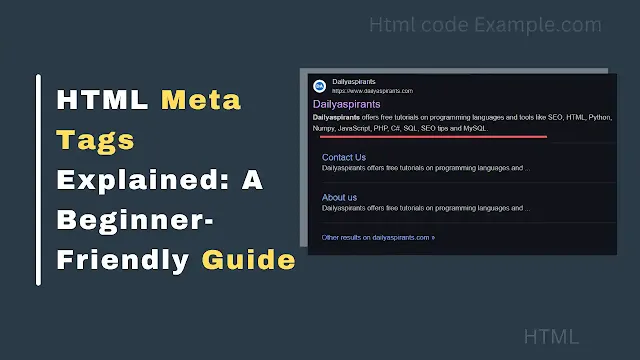Hey Friend, Let’s Dive Into HTML Meta Tags Together!
So, you’ve been exploring the wild and wonderful world of web development, and you keep hearing about these things called meta tags. Maybe you’ve spotted them hanging out in the <head> section of an HTML document and thought, “What’s the deal with these?”
Well, my friend, let me break it down for you in the simplest, friendliest way possible. By the end of this, you’ll not only understand meta tags but also know how to use them like a pro. Ready? Let’s go!.
What Are Meta Tags, Anyway?
Okay, imagine you’re writing a letter to a friend. You’d probably start with some basic info, like the date, your name, and maybe a little note about what the letter is about. Meta tags are kind of like that note they’re little snippets of information that tell browsers, search engines, and other techy things what your webpage is all about.
Meta tags live in the <head> section of your HTML document, and they don’t actually show up on the page itself. Instead, they work behind the scenes, like a backstage crew making sure everything runs smoothly.
Why Should You Care About Meta Tags?
Great question! Meta tags might seem small, but they’re super important for a few reasons:
They Help Search Engines Understand Your Page
Want your website to show up on Google? Meta tags like the description and keywords (more on that in a bit) help search engines figure out what your page is about. Think of it as giving Google a cheat sheet.
They Improve Your Website’s Usability
Meta tags can control how your site behaves. For example, they can tell browsers how to display your page on different devices (hello, responsive design!) or even prevent your page from being indexed if it’s not ready for the public.
They Make Your Site Look Good When Shared
Ever shared a link on social media and noticed a cool preview image or description? That’s thanks to meta tags like og:title and og:image (part of Open Graph protocol). They make your site look awesome when shared.
Common Meta Tags You’ll Actually Use
Alright, let’s get into the nitty-gritty. Here are some meta tags you’ll probably use at some point:
<meta charset="UTF-8">
This one’s a must-have. It tells the browser what character encoding to use (usually UTF-8, which covers pretty much all the characters you’ll ever need). Without this, your text might look like a bunch of random symbols. Yikes!
<meta name="description" content="A friendly guide to HTML meta tags!">
This is your page’s elevator pitch. It’s a short description that shows up in search engine results. Keep it clear and engaging!
<meta name="keywords" content="HTML, meta tags, web development, SEO">
Back in the day, this tag was super important for SEO. These days, search engines like Google don’t rely on it as much, but it’s still good practice to include relevant keywords. Just don’t stuff it with random words keep it natural!
<meta name="viewport" content="width=device-width, initial-scale=1.0">
This tag is a lifesaver for mobile-friendly websites. It ensures your site looks good on all devices by controlling the page’s width and scaling.
<meta name="robots" content="index, follow">
This tells search engines whether they should index your page and follow the links on it. If you don’t want your page to show up in search results, you can use noindex, nofollow instead.
Open Graph Tags (for Social Media)
These are meta tags specifically for social media platforms. They make your links look fancy when shared. Here’s an example:
<meta property="og:title" content="HTML Meta Tags Explained">
<meta property="og:description" content="Learn all about meta tags in a friendly, easy-to-understand way!">
<meta property="og:image" content="https://example.com/image.jpg">
A Quick Example
Here’s what a basic <head> section with meta tags might look like:
<!DOCTYPE html>
<html lang="en">
<head>
<meta charset="UTF-8">
<meta name="viewport" content="width=device-width, initial-scale=1.0">
<meta name="description" content="A friendly guide to HTML meta tags!">
<meta name="keywords" content="HTML, meta tags, web development, SEO, Open Graph, responsive design">
<meta name="robots" content="index, follow">
<meta property="og:title" content="HTML Meta Tags Explained">
<meta property="og:description" content="Learn all about meta tags in a friendly, easy-to-understand way!">
<meta property="og:image" content="https://example.com/image.jpg">
<title>HTML Meta Tags Explained</title>
</head>
<body>
<!-- Your awesome content goes here -->
</body>
</html>
Done: The Final Thoughts
Meta tags might seem like a small part of web development, but they’re like the secret sauce that makes your website shine. They help search engines understand your content, make your site look great on all devices, and even give your social media shares a boost. Plus, they’re super easy to add once you get the hang of it!
So, next time you’re working on a website, don’t forget to give your meta tags some love. They’re your website’s way of saying, “Hey, I’m here, and I’m awesome!” And who doesn’t want that?
Happy coding, friend!
If you ever get stuck, just remember: Google is your best friend. And so am I!
